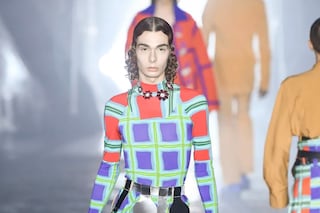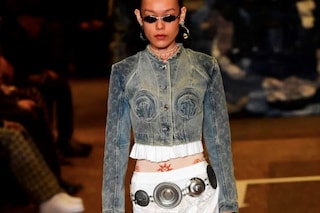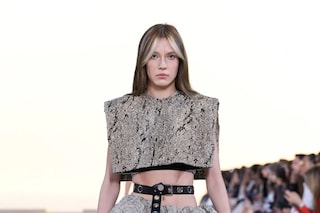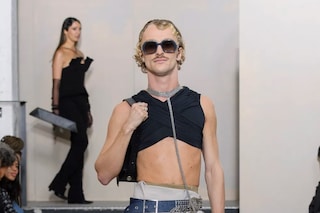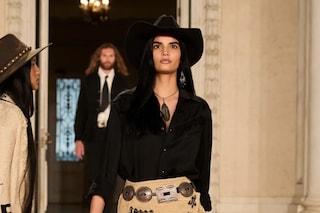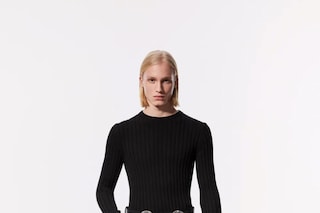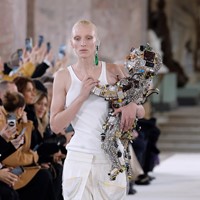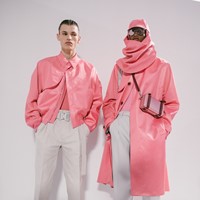From PinkPantheress to Marine Serre, what is behind the collective urge to start dressing like a 2003-era boho girlie?
When PinkPantheress arrives at the gig, the Depop disc belt comes off. She takes the shackles off her waist and hurls them to the ground like a gladiator in the throes of battle. I’m not sure what PinkPantheress song requires that level of stagecraft but there is evidence of it happening here. Slung across the hips with an air of Eat, Pray, Love, the disc belt was symptomatic of a time in culture when women felt a collective urge to start dressing like they had just opened a vintage stall on Portabello Road. It was about shapeless peasant skirts, off-putting sandals, and smoking roll-ups; slouchy boots, paisley-patterned dresses, and chunky bangles embedded with rough-hewn turquoise stones.
The disc belt reached its apotheosis between the years 2003 and 2005, namely because of Kate Moss, Sienna Miller, and the newfound eroticism of suede waistcoats and “hobo” bags. It didn’t cinch a silhouette so much as it flattened one, but it was knowingly sexy in a low-maintenance way. It also failed to fulfil a functional purpose: much like those thin scarves beloved of the Frazzled English Woman, the belt was a useless scaffolding for low-rise denim. When worn by a certain kind of person (posh, but keen to hide their privilege) the boho belt sent up a distress signal among west Londoners with the phrase “I’m just gonna pop down to Bikram yoga with my boyfriend who is in a band and wears neckerchiefs” telegraphed in skywriting.
I WANT TO GO TO THEREEEE pic.twitter.com/MP43mtIWcM
— vanessa ☆ (@vanessaferrea) February 7, 2023
I mention Bikram because the look is indebted to the spiritual practices of the Global South, albeit significantly white-washed. At a time when Vogue was first writing about wellness retreats in Goa, these were the sort of people that lined their interiors with Buddha statues, Navajo-print Ottomans, and fabric wall hangings. They were, after all, the proto-Bali gap year elephant tattoo beach swings on Instagram kind of wanderlusters. But this all surfaced long before the words “cultural appropriation” entered the mainstream, and when brought together in an aesthetic “boho” hodgepodge, the disc belt gestured to a “mood” – pseudo-spiritual, pseudo-folkish – rather than being a historically accurate portrayal of a certain demographic of people.
This is because fashion relies on selling the idea of something more than it does the thing itself. As a result, the particular origins of a garment become blurred. See Marine Serre’s AW23 collection, where she accessorised looks with belts strung together from plates. According to one writer, the disc belt is a descendant of the concho belt, which was worn by the Navajos who looted the look from Southern Plain Indians in the late 1800s. Over time, the belts got more flamboyant and were popularised by Jim Morrison of the Doors before brands like Ralph Lauren, Chloé, Ferragamo, Sacai, and Louis Vuitton transformed them into high fashion accessories. Is Shakira aware that she became famous for belly-dancing in a look that was actually stolen from an oppressed group some 200 years prior? Probably not.
It is a similar kind of time-flattening effect that’s happening to the Y2K aesthetic, which isn’t necessarily tethered to all the technological panic at the turn of the millennium – which is what the acronym stands for – but any and all of the looks that appeared in the early 2000s. That timewarp is made all the more queasy when most of the outfits that are being rediscovered are plucked from red carpets and music videos. Fatigued with rhinestoned McBling costumes, there is a cultural appetite for what “regular” people were actually wearing during the aughts, hence all those people on TikTok who are thrifting for boho belts in Salamon trainers and crocheted balaclavas. It means the normie – and all her concho belts and rustic skirts – is becoming a belated protagonist in the permafrosted 00s revival.

